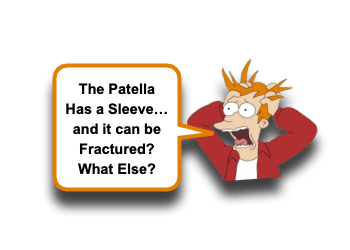Patellar Sleeve Fracture

We know that one of the unique aspects of children that must be accounted for when evaluating kids is their anatomic differences compared to adults. Certainly major traumatic injuries bring these differences to mind the most (ex, Thoracic Trauma, Abdominal Trauma, Head Trauma), but our evaluation of minor injuries is also affected (ex, Toddler’s Fracture, Elbow Injury, Nursemaid’s Elbow, Shoulder Injury). We commonly evaluate knee pain and the specific pediatric anatomy does deserve some special attention. Let us take a minute to review one unique pediatric condition – Pediatric Patellar Sleeve Fracture:
Patellar Sleeve Fracture: Anatomy
- The patella is part of the quadriceps extensor mechanism.
- The patella is the largest sesamoid bone in the body! (**Super sweet trivia to impress your family this Holiday season!**)
- The patella is held in place by the quadriceps tendon and patellar tendon.
- The ossification of the immature patella begins at 3-6 years of age. [Gao, 2008]
- Ossification continues into the 2nd decade of life.
- The softer cartilaginous patella tears more easily than the mature bone (similar to Salter Harris Injuries).
- Blood supply to the immature patella comes from the distal pole and the anterior surface. [Gao, 2008]
- The medial, proximal, and lateral portions do not have specific blood vessels.
- Injury to the anterior or distal / lower pole can lead to avascular necrosis of the proximal portions.
Patellar Sleeve Fracture:
- Patellar fracture is rare in children. [Gao, 2008; Dai, 1999]
- ~1% of all pediatric fractures.
- The immature patella is largely protected by the thick layer of cartilage.
- More pliable ligaments and tissues.
- Children also are less likely to be exposed to high energy impacts (although car collisions are still a significant risk factor).
- The Patellar Sleeve Fracture is the most common (38 – 73%) type of patellar fracture in pediatric patients. [Damrow, 2017; Gao, 2008]
- Patellar Sleeve Fracture = separation of the articular cartilage, retinaculum, periosteum, and small bony fragment of the patella. [Gao, 2008]
- Bony patellar fractures in skeletally mature patients are most often due to direct impact to the patella.
- Patellar sleeve fractures are more often due to powerful contraction of the quadriceps while knee is flexed. [Kimball, 2014]
- Sporting activities (ex, soccer)
- Falls onto feet from slight elevation (ex, monkey bars)
- Similar forces seen with Patellar Tendon Rupture.
- The Patellar Sleeve Fracture can be easily overlooked. [Damrow, 2017; Gao, 2008; Dai, 1999]
- Small avulsed bone can be missed or misinterpreted.
- Exam can be difficult to discern due to swelling.
- Delayed diagnosis does lead to worse outcomes.
- Patellar Sleeve Fracture: Clues [Damrow, 2017; Kimball, 2014; Gao, 2008]
- Hemarthrosis
- Inability to extend the knee
- Inability to bear weight
- Palpable gap (may be difficult to feel due to swelling)
- Xray Findings:
- Patella alta (“high riding” patella from inferior sleeve avulsion)
- Patella baja (“low riding” patella from superior sleeve avulsion)
- Small avulsed bone fragment
- Comparison X-rays of the other knee can be helpful!
- Ultrasound has been used to confirm diagnosis. [Kimball, 2014]
- MRI is eventually used to make the diagnosis and determine extent of injury.
- Patellar Sleeve Fracture: Complications [Damrow, 2017; Gao, 2008]
- Chronic anterior knee pain
- Limitation of knee flexion
- Extensor lag
- Patella alta
- Malunioin / nonunion
- Avascular necrosis
- Athrofibrosis
- Ectopic bone formation
- Patellar Sleeve Fracture: Management [Gao, 2008]
- The majority of these will do well with appropriate therapy.
- The goal is to achieve accurate reduction and reconstruction of the extensor mechanism! [Gao, 2008; Dai, 1999]
- Surgery will be recommended for most. [Gao, 2008; Dai, 1999]
- Still debated.
- For non-displaced sleeve fractures, some recommend conservative management.
- Open surgical reduction is considered for most.
Moral of the Morsel
- Kid with Swollen Knee following violent contraction of quads? Think Patellar Sleeve Fracture! You do not need direct impact!
- Scrutinize the X-rays! Comparison views can also be helpful!
- Don’t rely on the X-rays! The injury may not be visible on plain films!
References
Maloney E1, Stanescu AL1,2, Ngo AV1,2, Parisi MT1,2,3, Iyer RS1,2. The Pediatric Patella: Normal Development, Anatomical Variants and Malformations, Stability, Imaging, and Injury Patterns. Semin Musculoskelet Radiol. 2018 Feb;22(1):81-94. PMID: 29409075. [PubMed] [Read by QxMD]
Alassaf N1. Acute presentation of Sinding-Larsen-Johansson disease simulating patella sleeve fracture: A case report. SAGE Open Med Case Rep. 2018 Sep 10;6:2050313X18799242. PMID: 30210798. [PubMed] [Read by QxMD]
Damrow DS, Van Valin SE. Patellar Sleeve Fracture With Ossification of the Patellar Tendon. Orthopedics. 2017 Mar 1;40(2):e357-e359. PMID: 27798714. [PubMed] [Read by QxMD]
Leschied JR1, Udager KG2. Imaging of the Pediatric Knee. Semin Musculoskelet Radiol. 2017 Apr;21(2):137-146. PMID: 28355677. [PubMed] [Read by QxMD]
Kimball MJ, Kumar NS1, Jakoi AM, Tom JA. Subacute superior patellar pole sleeve fracture. Am J Orthop (Belle Mead NJ). 2014 Jan;43(1):29-32. PMID: 24490183. [PubMed] [Read by QxMD]
Beck NA1, Patel NM, Ganley TJ. The pediatric knee: current concepts in sports medicine. J Pediatr Orthop B. 2014 Jan;23(1):59-66. PMID: 24045503. [PubMed] [Read by QxMD]
Nath PI1, Lattin GE Jr. Patellar sleeve fracture. Pediatr Radiol. 2010 Dec;40 Suppl 1:S53. PMID: 20526592. [PubMed] [Read by QxMD]
Dupuis CS1, Westra SJ, Makris J, Wallace EC. Injuries and conditions of the extensor mechanism of the pediatric knee. Radiographics. 2009 May-Jun;29(3):877-86. PMID: 19448122. [PubMed] [Read by QxMD]
Gao GX1, Mahadev A, Lee EH. Sleeve fracture of the patella in children. J Orthop Surg (Hong Kong). 2008 Apr;16(1):43-6. PMID: 18453658. [PubMed] [Read by QxMD]
Dai LY1, Zhang WM. Fractures of the patella in children. Knee Surg Sports Traumatol Arthrosc. 1999;7(4):243-5. PMID: 10462215. [PubMed] [Read by QxMD]

